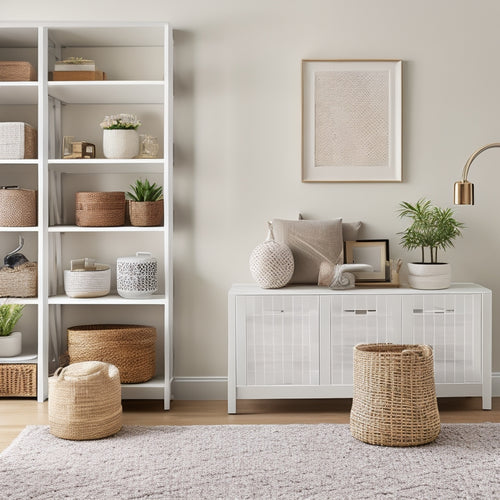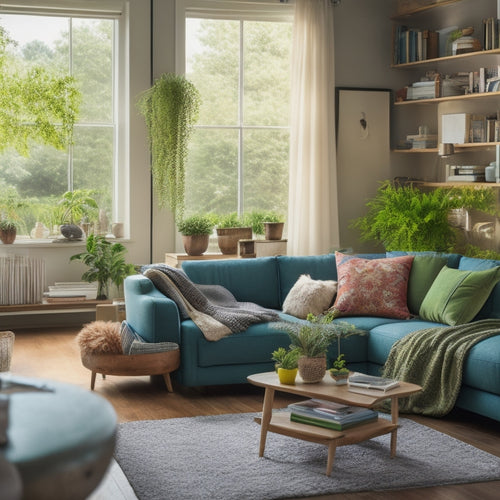
Mastering Kids' Closet Organization: Tips & Tricks
Share
Mastering kids' closet organization requires a structured approach that promotes responsibility, independence, and essential life skills. Establish a solid foundation by designating areas for accessories, using labeled storage bins, and providing a sense of control. Maximize storage space by utilizing bins creatively, categorizing items, and optimizing vertical space. Teach kids to maintain order by establishing routines, assigning responsibilities, and involving them in the process. By following these steps, parents can create a functional and clutter-free space that fosters valuable habits. With a well-organized closet, kids can develop essential skills that extend beyond their closet's walls, and discover the benefits of a well-structured space.
Key Takeaways
• Establish a solid organizational foundation in the closet to promote responsibility and teach life skills.
• Use storage bins with labels to keep items hidden yet accessible, creating a sense of control and order.
• Maximize closet storage space by utilizing vertical space, dividers, and small bins to prevent clutter.
• Teach kids habits and skills to maintain closet order, fostering independence and ownership through assigned routines and responsibilities.
• Involve kids in the maintenance process, encouraging them to put away items, hang up clothes, and keep the closet tidy.
Laying the Organizational Foundation
Because kids inherently crave order but often require guidance to maintain it, establishing a solid organizational foundation in their closet is essential for developing essential life skills and promoting a sense of responsibility.
A well-structured closet setup helps kids understand the importance of maintaining their belongings and encourages them to take ownership of their space. Organizing accessories, such as hats and dress-up clothes, into designated areas helps create a sense of control and order.
Utilizing storage bins with labels is an effective way to keep items hidden from view while keeping them easily accessible. By providing a solid foundation, kids can develop the skills they need to maintain their closet and eventually, other areas of their life.
Maximizing Closet Storage Space
How can you optimize the often-limited closet space to accommodate your child's growing collection of clothes, accessories, and memorabilia while maintaining a sense of order and accessibility?
By utilizing storage bins creatively, you can maximize drawer space and keep items tucked away yet still easily accessible. Here are a few strategies to explore:
-
Incorporating fun labels and categorizing storage bins by type or season can help your child quickly find what they need.
-
Maximizing drawer space with dividers or small bins can keep clothes organized and prevent clutter from building up.
-
Utilizing vertical space by installing shelves or hooks can provide additional storage for items like bags, hats, and accessories.
Teaching Kids to Maintain Order
Once the closet is organized, the next step is to teach kids the habits and skills necessary to maintain the newly created order, ensuring that their space remains clutter-free and functional over time. Involving kids in the maintenance process fosters independence and encourages them to take ownership of their space. By establishing routines and responsibilities, kids learn to put away items after use, hang up clothes, and keep their closet tidy.
| Task | Frequency | Responsibility |
|---|---|---|
| Putting away toys | Daily | Child |
| Hanging up clothes | Weekly | Child |
| Donating outgrown items | Monthly | Parent/Child |
Frequently Asked Questions
How Often Should I Reorganize My Child's Closet to Maintain Order?
To maintain order, implement a seasonal purge to remove outgrown items and conduct daily maintenance, such as tidying up and putting away toys, to uphold a clutter-free space that promotes organization and independence.
What Are Some Creative Ways to Repurpose Old Storage Bins?
"Envision a vibrant playroom where upcycled storage bins, transformed with paint and stickers, now store toys and art supplies. Try bin makeovers and container hacks to breathe new life into old containers, giving your child a sense of creative ownership."
Can I Involve My Toddler in the Organizing Process, or Is It Too Early?
Involving toddlers in organizing can foster Teaching Independence, creating Little Helpers. Start with simple tasks, like picking up toys or putting away clothes, to instill a sense of responsibility and ownership, laying the groundwork for lifelong organizational skills.
How Do I Handle It if My Child Resists Keeping Their Closet Organized?
"A million tiny tantrums can erupt when kids resist closet organization, but with emotional connection and parental patience, you can gently guide them towards maintaining order, fostering a sense of responsibility and self-pride in their space."
Are There Any Specific Closet Organization Systems That Work Best for Small Closets?
For small closets, consider installing Double Rods to maximize vertical space and utilize Shelf Dividers to categorize items, ensuring a structured and accessible organization system that optimizes storage capacity and promotes easy maintenance.
Conclusion
Effective closet organization is a valuable life skill that extends beyond the confines of the closet itself. By implementing the strategies outlined in this article, a well-organized closet can foster a sense of responsibility, independence, and self-management in children.
As they master the skills of maintaining a tidy and functional space, they will reap the benefits of improved time management, reduced stress, and increased productivity.
Related Posts
-

Taming the Chaos: 10 Home Storage Hacks
You're tired of living in a cluttered space, where chaos reigns supreme. To tame the mess, start by decluttering with...
-

What Busy Families Need for a Peaceful Home
You're already taking the first step towards a peaceful home by recognizing the importance of intentional systems and...

